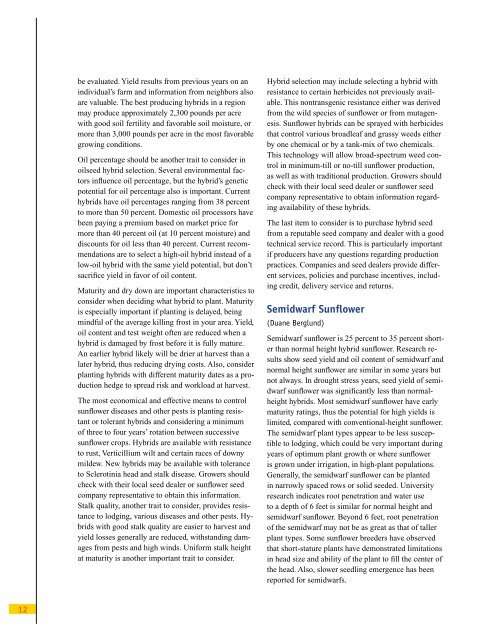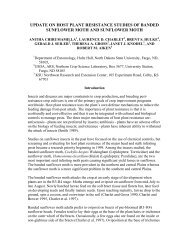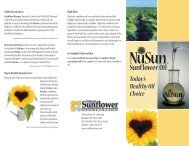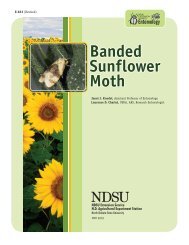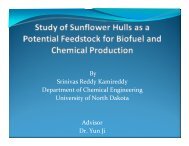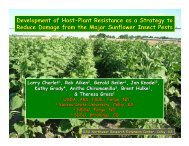Sunflower Production - NDSU Agriculture - North Dakota State ...
Sunflower Production - NDSU Agriculture - North Dakota State ...
Sunflower Production - NDSU Agriculture - North Dakota State ...
You also want an ePaper? Increase the reach of your titles
YUMPU automatically turns print PDFs into web optimized ePapers that Google loves.
e evaluated. Yield results from previous years on anindividual’s farm and information from neighbors alsoare valuable. The best producing hybrids in a regionmay produce approximately 2,300 pounds per acrewith good soil fertility and favorable soil moisture, ormore than 3,000 pounds per acre in the most favorablegrowing conditions.Oil percentage should be another trait to consider inoilseed hybrid selection. Several environmental factorsinfluence oil percentage, but the hybrid’s geneticpotential for oil percentage also is important. Currenthybrids have oil percentages ranging from 38 percentto more than 50 percent. Domestic oil processors havebeen paying a premium based on market price formore than 40 percent oil (at 10 percent moisture) anddiscounts for oil less than 40 percent. Current recommendationsare to select a high-oil hybrid instead of alow-oil hybrid with the same yield potential, but don’tsacrifice yield in favor of oil content.Maturity and dry down are important characteristics toconsider when deciding what hybrid to plant. Maturityis especially important if planting is delayed, beingmindful of the average killing frost in your area. Yield,oil content and test weight often are reduced when ahybrid is damaged by frost before it is fully mature.An earlier hybrid likely will be drier at harvest than alater hybrid, thus reducing drying costs. Also, considerplanting hybrids with different maturity dates as a productionhedge to spread risk and workload at harvest.The most economical and effective means to controlsunflower diseases and other pests is planting resistantor tolerant hybrids and considering a minimumof three to four years’ rotation between successivesunflower crops. Hybrids are available with resistanceto rust, Verticillium wilt and certain races of downymildew. New hybrids may be available with toleranceto Sclerotinia head and stalk disease. Growers shouldcheck with their local seed dealer or sunflower seedcompany representative to obtain this information.Stalk quality, another trait to consider, provides resistanceto lodging, various diseases and other pests. Hybridswith good stalk quality are easier to harvest andyield losses generally are reduced, withstanding damagesfrom pests and high winds. Uniform stalk heightat maturity is another important trait to consider.Hybrid selection may include selecting a hybrid withresistance to certain herbicides not previously available.This nontransgenic resistance either was derivedfrom the wild species of sunflower or from mutagenesis.<strong>Sunflower</strong> hybrids can be sprayed with herbicidesthat control various broadleaf and grassy weeds eitherby one chemical or by a tank-mix of two chemicals.This technology will allow broad-spectrum weed controlin minimum-till or no-till sunflower production,as well as with traditional production. Growers shouldcheck with their local seed dealer or sunflower seedcompany representative to obtain information regardingavailability of these hybrids.The last item to consider is to purchase hybrid seedfrom a reputable seed company and dealer with a goodtechnical service record. This is particularly importantif producers have any questions regarding productionpractices. Companies and seed dealers provide differentservices, policies and purchase incentives, includingcredit, delivery service and returns.Semidwarf <strong>Sunflower</strong>(Duane Berglund)Semidwarf sunflower is 25 percent to 35 percent shorterthan normal height hybrid sunflower. Research resultsshow seed yield and oil content of semidwarf andnormal height sunflower are similar in some years butnot always. In drought stress years, seed yield of semidwarfsunflower was significantly less than normalheighthybrids. Most semidwarf sunflower have earlymaturity ratings, thus the potential for high yields islimited, compared with conventional-height sunflower.The semidwarf plant types appear to be less susceptibleto lodging, which could be very important duringyears of optimum plant growth or where sunfloweris grown under irrigation, in high-plant populations.Generally, the semidwarf sunflower can be plantedin narrowly spaced rows or solid seeded. Universityresearch indicates root penetration and water useto a depth of 6 feet is similar for normal height andsemidwarf sunflower. Beyond 6 feet, root penetrationof the semidwarf may not be as great as that of tallerplant types. Some sunflower breeders have observedthat short-stature plants have demonstrated limitationsin head size and ability of the plant to fill the center ofthe head. Also, slower seedling emergence has beenreported for semidwarfs.12


